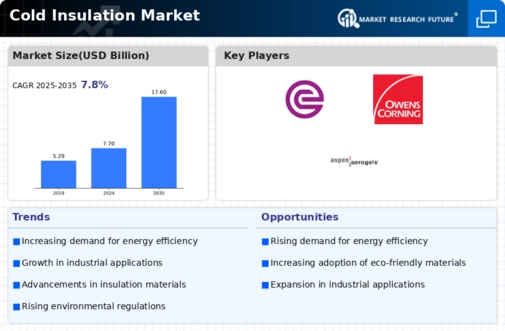Market Trends
Key Emerging Trends in the Global Cold Insulation Market
The Cold Insulation Market has observed major trends brought by the rapid increase of demand for energy-efficient products, the regulations that are aimed at proctecting the environment, and the growth of sectors that are in need for effective thermal insulation. Insulation is a key element in maintaining a low temperature environment, restricting and/or preventing heat transfer in a variety of industries ranging from oil and gas to chemicals and refrigeration. The green trend specifically includes aging into the formation of energy efficient and environment-friendly building and industrial facilities.
O&G is the key sector that determines trends in cold insulation along with other industries. The exploit and producing of hydrocarbons mostly occupy with the operating extreme harsh condition e.g. low temperature, therefore, seen as a chief from which heat transfer is prevented and efficiency is kept by taking good of cold insulation. This fast track is predicted to continue in view of the dynamic scale of oil and gas industry and the rising demand for durable insulation in the extreme areas of operation.
ESP and environmentally conscious regulation and standards as the driving forces behind the cold insulation industry are what companies in this industry are looking to adapt to quickly. In a large number of countries, governments have formulated a policy to lower carbon emissions and intensify energy-saving actions. Energy efficient cold internal materials are starting to be used in construction and the building standards which are aligned with the green building are becoming popular. On the one hand, this increase relies on greening and providing effective energy solutions with light footprint by the sector as the key target and goal.
Technology-driven innovations in the arena of insulation materials and manufacturing processes are the key responsibilities for being re-shaped the current market trends. Manufacturers are demonstrating interest in research and development of newer cold insulation material that provides good insulation, long life, and easy to install. The modernization of materials considered to be a state-of-the-art technology, which includes aerogels and vacuum insulation panels, is indeed a new trend in the game of Cold Insulation, and it presents a wide range of uses and choices in different industrial sectors.
Discoveries and innovations within the pharmaceutical and healthcare sectors are the now critical chief drivers of the cold insulating solutions demand. Taken place among cold storage and transport of such as temperature-sensitive vaccines, biological specimens, and medication is implied the need of maintaining the temperature range which is going to be achieved by the cold insulation. With respect to that more and more surfaces for infrastructure of healthcare and delivery of pharmaceutical products are used the Cold Insulation Market is facing an increase of cold chain logistics in the number of applications.
Just like the interests of world economies effect the Crude Insulation Market, trends also show this effect. Economy as a whole, for instance in areas such as building and manufacturing, directly derives the cold materials demand from the conditions of this economy. Swings in industrial activities and might cause relevant demand rigidity, giving leverage to suppliers which can subsequently hinder manufacturing processes to react to new conditions quickly.






Leave a Comment